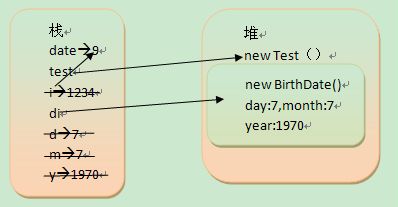Java_JVM内存管理
JVM内存涉及到的东西:


- 寄存器:最快的存储区, 由编译器根据需求进行分配,我们在程序中无法控制.
- 栈:存放基本类型的变量数据和对象的引用,但对象本身不存放在栈中,而是存放在堆(new 出来的对象)或者常量池中(字符串常量对象存放在常量池中。)
- 堆:存放所有new出来的对象。
- 静态域:存放静态成员(static定义的)
- 常量池:存放字符串常量和基本类型常量(public static final)。
- 非RAM存储:硬盘等永久存储空间
这里我们主要关心栈,堆和常量池。
基础类型的变量和常量以及变量和引用存储在栈中;常量存储在常量池中;对象存储在堆中。
栈中的数据大小和生命周期是可以确定的,当没有引用指向数据时,这个数据就会消失。堆中的对象的由垃圾回收器负责回收,因此大小和生命周期不需要确定,具有很大的灵活性。
字符串的存储:
对象的引用存在栈中;编译期直接用双引号定义的存在常量池中;运行期new出来的存在堆中。
内容相同的字符串在常量池中只有一份,而在堆中可以存在多份。看下面例子:
String s1 = "china";
String s2 = "china";
String s3 = "china";
String ss1 = new String("china");
String ss2 = new String("china");
String ss3 = new String("china");

int类型的存储:
int i1 = 9; int i2 = 9; int i3 = 9; public static final int INT1 = 9; public static final int INT2 = 9; public static final int INT3 = 9;
成员变量和局部变量的存储:
局部变量(方法或语句块内部、方法参数)的数据存在于栈内存中,随着方法的消失而消失。成员变量存储在堆中的对象里面,由垃圾回收器负责回收。
class BirthDate {
private int day;
private int month;
private int year;
public BirthDate(int d, int m, int y) {
day = d;
month = m;
year = y;
}
// 省略get,set方法………
}
public class Test {
public static void main(String args[]) {
int date = 9;
Test test = new Test();
test.change(date);
BirthDate d1 = new BirthDate(7, 7, 1970);
}
public void change1(int i) {
i = 1234;
}
}

对于以上这段代码,date为局部变量,i,d,m,y都是形参为局部变量,day,month,year为成员变量。下面分析一下代码执行时候的变化:
- main方法开始执行:int date = 9; date局部变量,基础类型,引用和值都存在栈中。
- Test test = new Test(); test为对象引用,存在栈中,对象(new Test())存在堆中。
- test.change(date); i为局部变量,引用和值存在栈中。当方法change执行完成后,i就会从栈中消失。
- BirthDate d1= new BirthDate(7,7,1970); d1 为对象引用,存在栈中,对象(new BirthDate())存在堆中,其中d,m,y为局部变量存储在栈中,且它们的类型为基础类型,因此它们的数据也存储在栈中。 day,month,year为成员变量,它们存储在堆中(new BirthDate()里面)。当BirthDate构造方法执行完之后,d,m,y将从栈中消失。
- main方法执行完之后,date变量,test,d1引用将从栈中消失,new Test(),new BirthDate()将等待垃圾回收。
